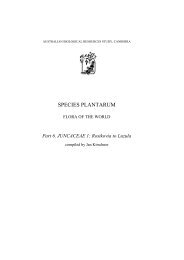Introduction - Species Plantarum Programme
Introduction - Species Plantarum Programme
Introduction - Species Plantarum Programme
You also want an ePaper? Increase the reach of your titles
YUMPU automatically turns print PDFs into web optimized ePapers that Google loves.
46<br />
SPECIES PLANTARUM — FLORA OF THE WORLD (1999)<br />
dendroid: tree-like in form but not in size. cf. arborescent.<br />
dentate: toothed.<br />
denticle: a small tooth; in Coprosma (Rubiaceae), thick papillate tubercles on the margin of<br />
the interpetiolar stipules.<br />
denticulate: finely toothed.<br />
depressed: flattened as if pressed down from the top or end.<br />
determinate: of growth or branching, with a bud or flower terminating the growth of the<br />
main axis; of an inflorescence, see definite.<br />
dextrorse: turned towards the right. cf. sinistrorse<br />
diadelphous: having the stamens united into two groups, or all but one united in a group and<br />
one free.<br />
diaphanous: extremely thin and transparent.<br />
dichasium: a cymose inflorescence with opposite branching below the flower which<br />
terminates each axis. cf. monochasium.<br />
dichlamydeous: of a flower, having two whorls of perianth parts.<br />
dichotomous: forking into two equal branches resulting from division of the growing point.<br />
diclinous: having the stamens and the carpels in separate flowers.<br />
dicotyledon: a flowering plant whose embryo has two (rarely more) cotyledons (seed<br />
leaves). cf. monocotyledon.<br />
didymous: borne in pairs; of anthers, having two lobes, with scarcely any tissue connecting<br />
them.<br />
didynamous: of stamens, four in number, two being distinctly longer than the other two.<br />
digitate: branching from the axis or stalk like the fingers of a hand.<br />
dimidiate: appearing to be halved, as when half an organ is so much smaller than the other<br />
that it seems absent.<br />
dimorphic: of two different forms.<br />
dioecious: having the male and female reproductive structures on separate plants. cf.<br />
monoecious.<br />
diplecolobous: of cotyledons in a seed, twice folded transversely.<br />
diploid: having two of the basic sets of chromosomes in the nucleus. cf. haploid, polyploid.<br />
disc: a plate or rim of tissue, derived from the receptacle of a flower, occurring between<br />
whorls of floral parts.<br />
discolorous: of different colours; of leaves, having the two surfaces different in colour;<br />
variegated. cf. concolorous.<br />
dissepiment: a partition (septum) within an ovary or fruit, derived by fusion of adjacent<br />
carpels.<br />
distal: remote from the point of origin or attachment. cf. proximal.<br />
distichous: arranged in two rows on opposite sides of a stem and thus in the same plane.<br />
diurnal: of flowers, opening only during daylight hours.<br />
divaricate: widely spreading and often ±horizontal.












